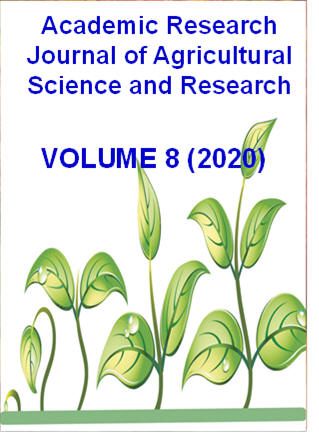|
ISSN: 2360-7874 |
Academic Research Journal of
Agricultural Science and Research |
|||||||||||||||||||
|
Vol. 8(4), pp. 411-417, May 2020 Research Foliage litter decomposition of agroforestry shrub species in Dello-menna District of Bale Zone, Southeast Ethiopia
Wondmagegn Bekele1*, Lisanework Nigatu2 and Lemma Wogi2
1Sinana Agricultural Research Center of Agroforestry Research team, Bale-Robe, Ethiopia 2Haramaya University School of Natural Resource management and Environmental Sciences, Haramaya, Ethiopia
Accepted 26 May 2020
In agroforestry land use system soil productivity is maintained via the decomposition of tree/shrub species biomass input mainly foliage’s litter material. The quality of foliage litter material could be considerably varied among species. Hence, better soil management decision in agroforestry land use system remains on identification and use of the desirable species biomass input based on their decomposition characters. A study was conducted to evaluate the decomposition pattern of foliage litter materials of three agroforestry shrub species grown in Dello-menna district of Bale zone, Southeast Ethiopia. In the study single exponential model was employed to determine the decay rate of decomposing litter materials as the dependency of degradation rate on some litter chemical quality indices examined by using Pearson’s correlation coefficient. Results showed that the fastest decomposition rate was 0.037 day-1 for S. sesban followed by 0.017 day-1 for C. cajan and the least 0.014 day-1 for F. macrophylla. The explained variation in rate of decomposition among the tested species was found to be due to the effects of some litter chemical quality parameters. Accordingly lignin, cellulose, lignocelluloses index and C/N ratio were reported as impeding parameters whereas phosphorus and nitrogen identified as facilitators. Indeed, among the species S.sesban was recommended as the most suitable species for short term soil fertility management purpose. However, the accelerated decomposing character of S.sesban foliage litter may limits its potential for long-term build-up of soil fertility. Alternatively F.macrophylla majorly and C.cajan in some case can be considered for long-term build-up of soil organic matter.
Keywords: Cajanus cajan, Flemingia macrophylla, Incubation period, Sesbania sesban
How to cite this article (APA Style): Wondmagegn B., Lisanework N., Lemma W (2020). Foliage litter decomposition of agroforestry shrub species in Dello-menna District of Bale Zone, Southeast Ethiopia. Acad. Res. J. Agri. Sci. Res. 8(4): 411-417
|
|||||||||||||||||||
